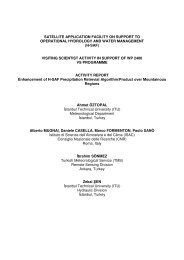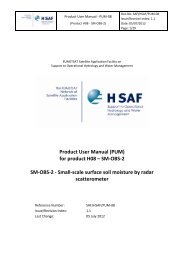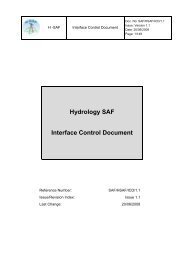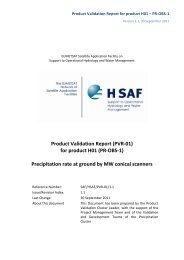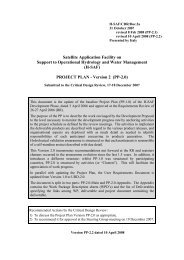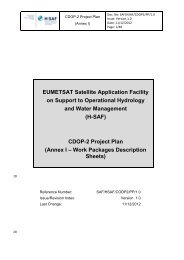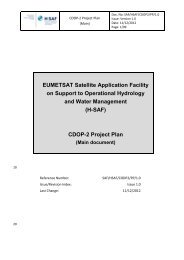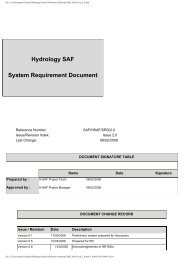H-SAF Product Validation Report (PVR) PR-OBS-3
H-SAF Product Validation Report (PVR) PR-OBS-3
H-SAF Product Validation Report (PVR) PR-OBS-3
Create successful ePaper yourself
Turn your PDF publications into a flip-book with our unique Google optimized e-Paper software.
<strong>Product</strong>s <strong>Validation</strong> <strong>Report</strong>, 30 May 2010 - <strong>PVR</strong>-03 (<strong>Product</strong> <strong>PR</strong>-<strong>OBS</strong>-3) Page 26<br />
meteorological environment, the Cloud Type product is the most useful as it distinguishes high-level<br />
and optically thick clouds from medium- and low-level clouds; and optically thin clouds. It is also<br />
useful for analyzing the cloud systems that have occurred at the time of satellite measurements.<br />
<strong>SAF</strong>IR lightning system works operationally at Hungarian Meteorological Service. We have five<br />
stations. The accuracy of the lightning network has been significantly increased the last two due to<br />
the large amount of case studies investigated during summer periods. Therefore we intend to use the<br />
lightning data, first of all in visual comparison as descriptor of the synoptic situation.<br />
The main steps of the precipitation products validation procedure are:<br />
Time and space alignment of the data from different sources, represented on different scales – pixel<br />
size of radar and satellite data is not the same. Especially in the case of microwave measurements,<br />
we have large footprints that need to be treated carefully. The time alignment can be solved by<br />
simply matching the closest data available in time to the H-<strong>SAF</strong> products. There are advanced<br />
methods to solve the up-scaling of ground and/or the down-scaling of satellite precipitation data.<br />
The OMSZ-Hungarian Meteorological Service uses the techniques discussed and proposed by the<br />
members of the validation group. We will contribute to the selection of the appropriate method and<br />
to the investigation of the accuracy of the matching method.<br />
The common task of the Precipitation <strong>Validation</strong> Group is the statistical validation. The up-scaling<br />
method has a key role in this process. We can only compare the radar, satellite, raingauge, and<br />
lightning if we have previously determined the coherent values from different sources. The data will<br />
be collected into one file containing the following information to calculate statistic values either for<br />
15 minutes samples, and for accumulated total precipitation information (over 3, 6, 12, 24 hours):<br />
- radar-derived precipitation intensity,<br />
- the satellite product values derived by H-<strong>SAF</strong>.<br />
Statistical characteristics (RMS, BIAS, etc) will be then calculated between the satellite-based<br />
precipitation and radar data for the different cases. These statistics will be performed for different<br />
periods (months, summer-winter, day-night) as well as for some satellite pass in extreme cases .<br />
We will also calculate multi-categorical statistics according to the classes determined by common<br />
agreement by the validation group and the hydrologists. We will prepare contingency tables, scatter<br />
plots and bias distribution functions to illustrate the performance of the precipitation products. These<br />
statistics will be performed for different periods (months, summer-winter, day-night) and maybe for<br />
some specific satellite passes. H-<strong>SAF</strong> data is going to be verified against radar data which preferably<br />
will be adjusted to rain gauge data. Our radar data is already gauge-adjusted in the case of 12, and 24h<br />
total precipitation.<br />
The first task to the preparation of case studies is the selection of the periods with significant rain<br />
amounts. This is done by the plotting of the radar and satellite rainfall estimate sums on a daily basis<br />
of each month.<br />
The second task to the preparation of case studies is the collection of all relevant data to the period<br />
in question. This means the collect of radar, lightning data, and of MSG images and <strong>SAF</strong>NWC<br />
products which correspond to the time period investigated.<br />
The visual comparison including both rain gauge and radar data is an inevitable tool for the<br />
understanding of the validation results of H-<strong>SAF</strong> products, because it:<br />
- provides an overall picture of the H-<strong>SAF</strong> database (resolution, territories seen, general values)<br />
- highlights similarities and differences in the structures and in the values<br />
- helps to monitor the meteorological situation as well<br />
To visualize the different products and to make subjective comparison we use the Hungarian Advanced<br />
Weather Workstation (HAWK) developed by OMSZ-Hungarian Meteorological Service which can<br />
interpret all kind of meteorological products together.




